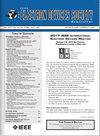Impact of Defects on the Low-Field Electron Mobility in GaN-on-Si HEMTs
IF 2.4
3区 工程技术
Q3 ENGINEERING, ELECTRICAL & ELECTRONIC
引用次数: 0
Abstract
In this work, we investigate the field and temperature dependence of the electron mobility in aluminum-gallium-nitride/gallium-nitride (AlGaN/GaN) high electron mobility transistors (HEMTs) realized on GaN-on-silicon (Si) substrates. For this purpose we employ an extraction method to eliminate parasitic and fringing effects. Our results show that especially at low fields the temperature dependence of the mobility, and consequently that of the specific on-resistance, is strongly affected by stress-induced charged dislocation scattering. For explaining the mobility behaviour at low fields, the subthreshold operation regime of the HEMTs has also been analyzed. An interface trap density at the AlGaN/GaN interfaceGaN-on-Si hemt中缺陷对低场电子迁移率的影响
在这项工作中,我们研究了在GaN-on-silicon (Si)衬底上实现的铝-氮化镓/氮化镓(AlGaN/GaN)高电子迁移率晶体管(HEMTs)中电子迁移率的场和温度依赖关系。为此,我们采用了一种提取方法来消除寄生和边缘效应。我们的研究结果表明,特别是在低场下,迁移率的温度依赖性以及相应的比导通电阻的温度依赖性受到应力诱导的带电位错散射的强烈影响。为了解释在低场下的迁移行为,我们还分析了hemt的阈下工作机制。在与温度无关的AlGaN/GaN界面$(N_{\textrm {it}})$ ($\sim ~6.9\ × 10^{10}$ cm−2)处提取出的界面陷阱密度与从迁移率测量中提取的位错密度接近。这表明,除了迁移率降低外,GaN层中相对较高的位错密度(这是GaN-on- si衬底中用于容纳应变差的缓冲层仍然不完善的结果)对$N_{\textrm {it}}$产生影响,从而产生亚阈值振荡。
本文章由计算机程序翻译,如有差异,请以英文原文为准。
求助全文
约1分钟内获得全文
求助全文
来源期刊

IEEE Journal of the Electron Devices Society
Biochemistry, Genetics and Molecular Biology-Biotechnology
CiteScore
5.20
自引率
4.30%
发文量
124
审稿时长
9 weeks
期刊介绍:
The IEEE Journal of the Electron Devices Society (J-EDS) is an open-access, fully electronic scientific journal publishing papers ranging from fundamental to applied research that are scientifically rigorous and relevant to electron devices. The J-EDS publishes original and significant contributions relating to the theory, modelling, design, performance, and reliability of electron and ion integrated circuit devices and interconnects, involving insulators, metals, organic materials, micro-plasmas, semiconductors, quantum-effect structures, vacuum devices, and emerging materials with applications in bioelectronics, biomedical electronics, computation, communications, displays, microelectromechanics, imaging, micro-actuators, nanodevices, optoelectronics, photovoltaics, power IC''s, and micro-sensors. Tutorial and review papers on these subjects are, also, published. And, occasionally special issues with a collection of papers on particular areas in more depth and breadth are, also, published. J-EDS publishes all papers that are judged to be technically valid and original.
 求助内容:
求助内容: 应助结果提醒方式:
应助结果提醒方式:


